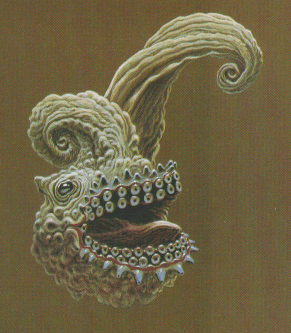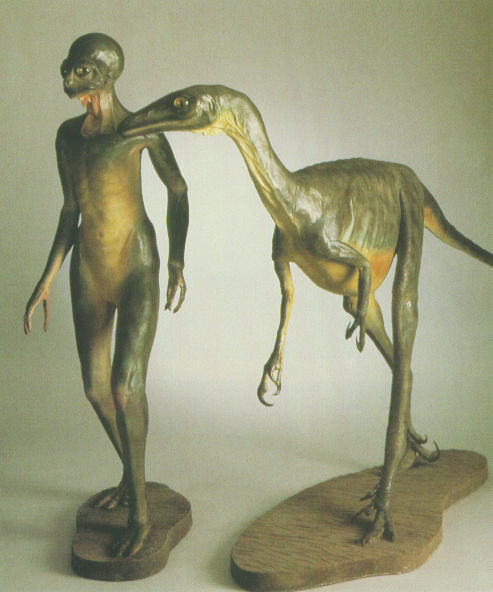| Home | class
topics grading rules |
resources links reading |
contacts feedback office hours |
|
||
intelligence and: |

|

|

|
 |
 |
 |
Evolution of Intelligence II
Facilitating factors:
diet
"hands"
social organization
neoteny
habitat
questions & assignment
Diet facilitates the development of intelligence depending on the extent to which intelligence is helpful to finding that sort of food. Any food that requires some effort to find will tend to reward increases in intelligence. This is why predators are generally smarter than their prey, except in the special case where they are smaller and are called parasites. (There is a reason for this: the lives of parasites are so iffy, both in terms of finding a host and of finding a mate, that they tend to concentrate on producing vast numbers of offspring in the hope that one of them will make it. They don't have energy left over for such fancy stuff as brains.) However, higher intelligence is not required just because an animal is a carnivore. Some of the most pea-brained mammals are insectivorous shrews.
A diet that requires memory is the one most often associated with intelligence. Fruit-eaters (frugivores, technically speaking) are the classic example. Fruit is generally seasonal and locally abundant, but otherwise rare. There is plenty on a given tree, but it is otherwise scarce. The ability to remember the location of a good fruit tree confers a huge advantage on a fruit eater. The local abundance means that you may as well share it with others, since much of it will go bad before one animal could finish all of it. Therefore a frugivorous diet is highly compatible with a social lifestyle, which is the other big contributing factor to intelligence.
In the Garden of Eden we are supposed to have started out on fruit and fruit has been highly respectable ever since. However, another significant food source shares many of the same ecological characteristics as fruit, and that is: the carcasses of large animals. Scavengers need to be able to remember where the carcasses are and they may as well share the find because the corpse will be useless in short order. Large carcasses would also reward the ability to use tools because they have thick hides that need cutting and bones that can be crushed to extract the extraordinarily nutritious marrow within. Some anthropologists theorize that the ability to crush bones using tools was actually what saw the earliest humans through the lean times. The only competitor for that food is the hyena because no other animal has enough jaw strength. A scavenging lifestyle would probably also reward the use of fire, since cooking would remove some of the inevitable bacterial load. (I find it very interesting in this context that we humans prefer aged instead of fresh red meat. Beef, for instance, is hung for variable lengths of time--under carefully controlled, refrigerated conditions in our brave new world--from a week to as long as a month.)
"Hands" or any other means of manipulation
 |
| (From Dickinson and Schaller) |
The ability to recognize objects and to use them as a means to an end, in other words as tools, is one of the characteristics of higher intelligence. However, if an animal lacks the physical equipment to use a tool, in other words if it lacks some way of manipulating objects, it is difficult to see how it could develop the cognitive processes associated with tool-use. Humans are unique on our planet in using languages with grammars, but they are also unique in their dexterity at manipulating objects. The fossil record indicates that opposable thumbs came before the big increases in brain size.
It seems likely that any creature developing high intelligence will need to have some means of manipulation before that intelligence can really fulfill its potential.
Social animals
Dealing with conspecifics, that is, members of the same species, increases intelligence, and dealing with them more increases it more. The simplest type of social organization is a family unit while the young are being cared for. This takes very little intelligence. Slightly more complex are groups of adult animals as well as young who operate independently but stay in close proximity for protection or to follow the best foragers. Herds of cattle, some flocks of birds and schools of fish are examples. Again, although some intelligence is needed, it is not very much. More complex groupings, in which members cooperate to achieve goals, as seen in dolphins, chimpanzees, wolf packs, and humans, require significantly more intelligence. It is, of course, true that to form such groups the members already need to have considerable intelligence, but it is also true that being in the groups promotes the further development of intelligence.
 |
| If we stumbled
on a scene like this on a distant world, at least four factors would make
us assume intelligence: social, neotenous tool- and fire-users who seek
shelter. We would be nonplussed if they did not talk. (From Dickinson and
Schaller) |
The point here is that higher intelligence is likeliest to develop in highly social animals.
The question immediately arises, what about the highly social insects, in that case? Certainly ants and bees, who have food sources that need memorization, who participate in complex societies, and who can manipulate things to some degree, would seem to have all the facilitating factors mentioned. What they do not have is an evolutionary history that gives them the option to grow big enough to have a large brain. And without a large brain, much learning is impossible. Once learned, any particular behavior requires relatively fewer neurons, but the ability to do something new requires lots of excess capacity.
Evolution of Intelligence III
Technological intelligence
There are a couple of contributing factors to the kind of technological intelligence we have that I would like to discuss.
Neoteny
 |
| Dinoman, by Dale Russell, Canadian Museum of Nature. A possible result of neoteny in the dinosaur on the right, a Stenonychosaurus. (From Dickinson and Schaller.) |
 |
| The stereotypical "alien" is severely neotenous, showing our bias for assuming that neoteny is evidence of advancement. (© clubalien.com) |
In order to be capable of truly complex learning, and hence complex levels of intelligence, it is essential to have a long period during which learning can take place. However, learning carries at a high price in terms of survival because the whole process implies precisely that the animal in question does not know the answer. Not knowing the answer is often fatal in nature, so learning can only occur in a relatively protected environment. The period of parental care while an animal is young is such an environment. This means that learning in animals is limited to juvenile stages, the more primitive the animal the more limited. Animals with more highly developed brains that have evolved from these earlier forms are still constrained by their evolutionary history: that is, they can only learn as juveniles. The solution is to extend the period of juvenility into adulthood.
Neoteny (or even more polysyllabically, paedomorphosis) is the term for a developmental shift that retains juvenile characteristics until later and later ages and puts off sexual maturity. (The ability to reproduce is nature's definition of adulthood and is associated with all sorts of adult characteristics, including a reduced ability to learn.) Humans are an extreme example of such a shift. Even at sexual maturity, we still look like relatively hairless, baby chimpanzees and we retain more or less ability to learn even in old age, to say nothing of adulthood.
(We are so strongly predisposed in favor of neoteny that our intuitive definitions of "nice" versus "not-nice" are largely a summary of neotenous versus non-neotenous traits. Children have proportionately larger eyes, bigger heads and smaller jaws that adults. These traits are evident in the good guys of science fiction, certainly the simpler kinds of visual science fiction often found in movies and TV. The bad guys, in contrast, have small heads or small eyes, big jaws, brow ridges, skull crests, meaty body types, and so forth and so on.)
Given plausible evolutionary histories, neotenous creatures seem like the likeliest to develop high levels of intelligence.
Habitat
Primitive technology does not require power beyond what a human or similar animal could generate. To make a club or a lever requires only the ability to chip stone or wood. However, higher levels of technology require harnessing some outside source of power that can amplify plain muscles. It is impossible, for instance, to make a car with your bare hands. Among humans, the earliest source of power was fire. Subsequently it was contrivances such as water- and wind-driven wheels, and currently we have subtleties such as photovoltaics and nuclear fission.
It is hard to judge whether the initial step of using fire is critical. Humans spent a couple of million years with nothing but fire, but perhaps a more mechanically gifted species could go straight to, for instance, water wheels. If that is impossible, and if fire is essential, then highly technological societies are initially limited to terrestrial environments. Fires can only be built on land, not under water and not in the air. If, on the other hand, a fire-using stage is not essential, then an ocean-based intelligence could, for instance, extract power from the movement of water. Just how an air-based intelligence might go about assembling the necessary bits and pieces to build power plants, even simple ones like windmills, is hard to imagine. But who knows? Life under 600 meters of rock was also hard to imagine.
Questions/Assignments
Insects, as a diet, would seem to present many of the problems of "difficult" food: they need to be found, it may well be worth remembering where the colonial ones have their nests, and they are a high energy food source that frees up time for activities other than eating. However, no insectivores are particularly intelligent. Why might this be? (For instance, how plentiful is this food source? Do the insectivores have evolutionary constraints?)
What sources of power would be available to relatively primitive water- and air-dwellers?
 |
The magnificent floating giants from the cover of Dickinson and Schaller. The creatures have small internal crab-like symbionts who act as their hands. These beings use an unspecified technology to process floating membranous plants into tools, dwellings, and spaceports. Could the crab-like creatures have used the surface of the giants to anchor things while they work on fabrication? |
Assignment: Choose three implausible extraterrestrials from Barlowe's Guide to Extraterrestrials and discuss what the problems are with their biological and social backgrounds. Why is their evolution implausible? Which factors are missing that could have driven the evolution of intelligence? Would their planets be likely to support life, to say nothing of mind? Are their societies plausible environments for the development of higher cognitive functions?
Choose another three extraterrestrials from the same book and discuss what makes them plausible. How do the planetary and biological factors mentioned and the morphology of the creatures as drawn all fit together to make a coherent whole?
If you would like suggestions as to which aliens to study, try the Abyormenite, Black Cloud, Cinruss, Cryer, Czill, Guild Steersman, Medusan, Mother, Soft One, or Athshean.